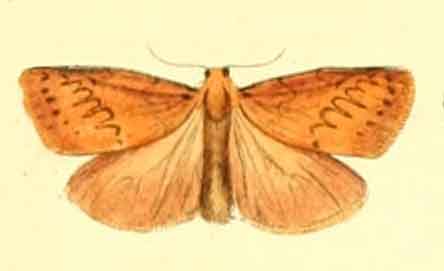
Superregnum: Eukaryota
Cladus: Unikonta
Cladus: Opisthokonta
Cladus: Holozoa
Regnum: Animalia
Subregnum: Eumetazoa
Cladus: Bilateria
Cladus: Nephrozoa
Cladus: Protostomia
Cladus: Ecdysozoa
Cladus: Panarthropoda
Phylum: Arthropoda
Subphylum: Hexapoda
Classis: Insecta
Cladus: Dicondylia
Subclassis: Pterygota
Cladus: Metapterygota
Infraclassis: Neoptera
Cladus: Eumetabola
Cladus: Endopterygota
Superordo: Panorpida
Cladus: Amphiesmenoptera
Ordo: Lepidoptera
Subordo: Glossata
Cladus: Coelolepida
Cladus: Myoglossata
Cladus: Neolepidoptera
Infraordo: Heteroneura
Cladus: Eulepidoptera
Cladus: Ditrysia
Cladus: Apoditrysia
Cladus: Obtectomera
Cladus: Macroheterocera
Superfamilia: Noctuoidea
Familia: Erebidae
Subfamilia: Arctiinae
Tribus: Lithosiini
Subtribus: Nudariina
Genus: Miltochrista
Species: Miltochrista miniata
Subspecies: M. m. miniata – M. m. mosbacheri
Name
Miltochrista miniata (J.R. Forster, 1771)
Synonyms
Phalaena Geometra miniata J.R. Forster, 1771
Noctua rubricunda Denis & Schiffermüller, 1775
Bombyx rosea Fabricius, 1775
Pyralis minialis Thunberg, 1784
Phalaena rosacea Fourcroy, 1785
Phalaena Tortrix roseana de Villers, 1789
Miltochrista miniata mosbacheri Roesler, 1967
References
Additional references
Roesler, R.-U. 1967. Beschreibung einiger neuer Taxa der Lithosiinae (Lepidoptera) aus der Paläarktis. Zeitschrift der Wiener Entomologischen Gesellschaft 52: 67-76.Full article (PDF). Reference page.
Vernacular names
English: Rosy Footman
français: Rosette
svenska: Rosenvinge
Miltochrista miniata, the rosy footman, is a moth of the family Erebidae. The species was first described by Johann Reinhold Forster in 1771. It is found in the temperate parts of the Palearctic realm – Europe, Asia Minor, Caucasus, northern Kazakhstan, southern Siberia, Amur, Primorye, Sakhalin, southern Kuriles, Heilongjiang, Liaoning, Hebei, Inner Mongolia, Shanxi, Sichuan, Korea and Japan, but may be replaced by Miltochrista rosaria in the eastern Palearctic.
Miltochrista miniata
Technical description and variation
For a key to the terms used, see Glossary of entomology terms.
The wingspan is 23–27 mm. Tannish-peach ground colour, rose-red margin to the forewing, and on this wing a black dentate line beyond the middle, and black, elongate spots before the margin. In the male the costa is curved upwards beyond the apex of the cell. In ab. rosaria Butler (now full species Miltochrista rosaria), which is commoner in the east of the area of distribution than in the west, and is perhaps a distinct species, the ground colour is more yellow; and in ab. crogea Bignault the wings are quite pale yellow, the forewing being edged with bright yellow.[1]
Moth, larva and cocoon in Karl Eckstein Die Schmetterlinge Deutschlands (figure 7-7c)
Biology
The moth flies from June to September depending on the location. Often occurs singly, in broadleaf and mixed forests, on moors, at road-side ditches, on umbellifers or scabious.
Egg oval, yellow. Larva grey, with blackish head, with long and dense hairs, hibernating, until June on lichens on walls and fences. The caterpillars feed on lichen. Pupa black-brown, abdomen with yellow incisions, in a cocoon densely intermixed with hairs.
References
Seitz, A. Ed. Die Großschmetterlinge der Erde, Verlag Alfred Kernen, Stuttgart Band 2: Abt. 1, Die Großschmetterlinge des palaearktischen Faunengebietes, Die palaearktischen Spinner und Schwärmer, 1912- 1913
External links
Wikimedia Commons has media related to Miltochrista miniata.
Kimber, Ian. "72.035 BF2037 Rosy Footman Miltochrista miniata (Forster, 1771)". UKMoths. Retrieved 14 October 2019.
Fauna Europaea
Savela, Markku. "Miltochrista miniata (Forster, 1771)". Lepidoptera and Some Other Life Forms. Retrieved 14 October 2019. Taxonomy
Lepiforum e.V.
Retrieved from "http://en.wikipedia.org/"
All text is available under the terms of the GNU Free Documentation License

